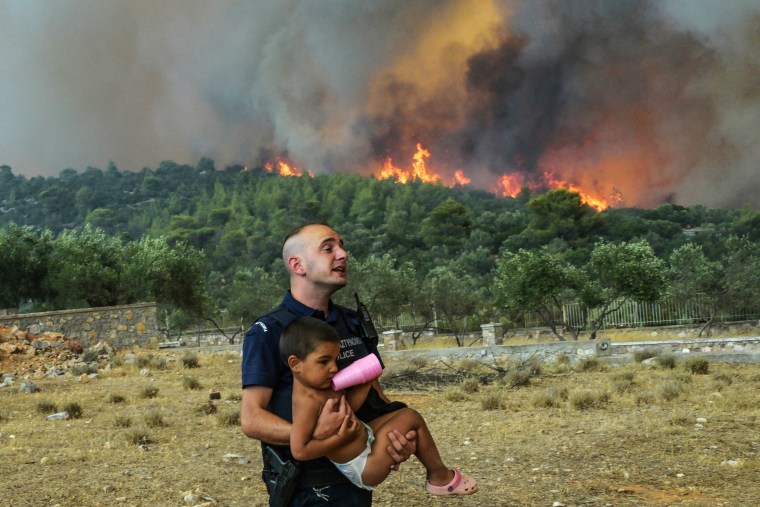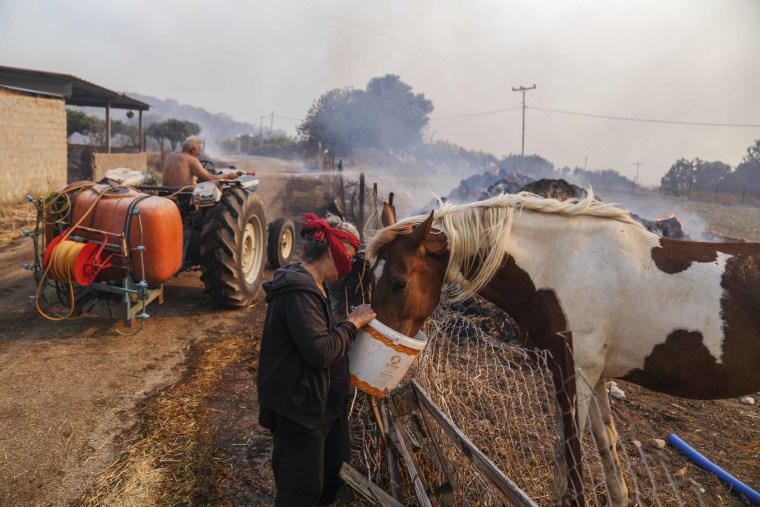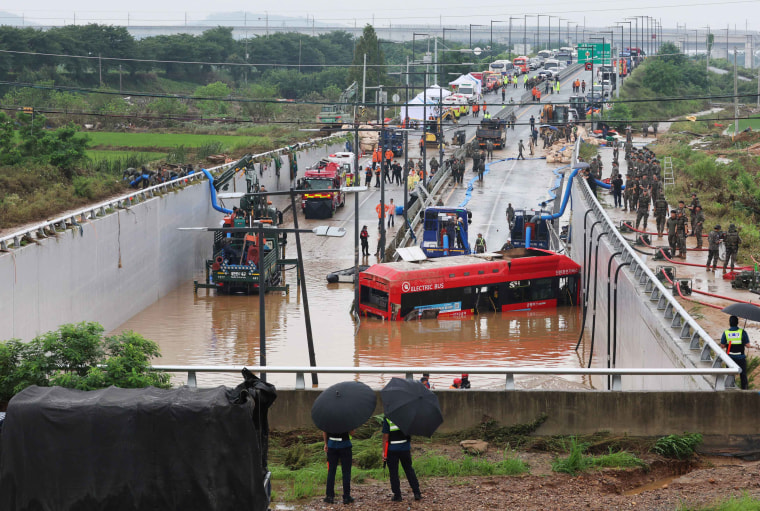HONG KONG — Parts of Asia and southern Europe braced for scorching temperatures and violent storms Tuesday as world weather experts warned of increased risk of deaths caused by extreme weather across the globe.
“Temperatures in North America, Asia, and across North Africa and the Mediterranean will be above 40° C (104° F) for a prolonged number of days this week as the heatwave intensifies,” the World Meteorological Organization said.
Parts of Spain, Italy and Greece were in "very extreme danger" of fires, the European Union's emergency management service said in a tweet.
The Italian island of Sardinia could see highs of more than 47 Celsius (116 Fahrenheit). Temperatures could hit 104 degrees F in other Italian cities.
Rome braced for temperatures as high as 107 degrees, with officials distributing bottled water and guiding tourists to fountains.

“We helped at least 11 people this morning who felt unwell because of the heat, some fainted, other needed to get in the shade and take a break,” Giuseppe Napolitano, head of the Civil Protection Agency in Rome, told NBC News.
The heat in Spain intensified during the day, and wildfires burned uncontrollably on the Canary Island of La Palma, forcing more than 4,000 residents to be evacuated.
Blazes were also intensified near the Greek capital of Athens, forcing residents to flee their homes and prompting evacuation of hundreds of children from a summer camp.
The blaze broke out in the village of Kouvaras, about 17 miles from Athens, fanned by the erratic winds, a Greek fire service official said, adding 200 firefighters with over a dozen aircrafts were trying to control the flames.
In Switzerland too, almost 150 emergency responders scrambled to douse flames as a forest wildfire spread with authorities ordering the evacuation of several mountain villages, the police said in a briefing on Monday.

Meanwhile in China, Talim became the first typhoon to make landfall this year, knocking out power for almost 15,000 in Guangdong in southern China, much of which was restored on Tuesday, local officials said in a statement.
As the storm approached with winds up to 87 miles an hour, schools and the stock market remained shuttered in Hong Kong on Monday as it sideswiped the Chinese territory and headed toward the island province of Hainan.
Over the weekend, temperatures across China’s arid northwest set a national record, hitting a high of almost 126 degrees on Sunday in the Xinjiang region. The capital city of Beijing is enduring one of its hottest summers in its half a century of record keeping, with mercury soaring over 104 degrees for three days straight in June.
Experts warned that the worst was not over, with climate change caused by greenhouse gas emissions that hasaffected almost every part of the world.
“Wherever you are on this planet, this summer and the months looking forward, there are likely going to be more extremes,” Hannah Cloke, a climate scientist and a hydrology professor at the University of Reading in the U.K., told NBC News.
This year, especially, she said, conditions are expected to worsen due to El Niño — a climate pattern developing in the Pacific Ocean.

“We’ve got this injection of heat energy into the Pacific. When we get more energy in the oceans and the atmosphere, we can get stronger storms, diversions of weather systems that can cause droughts in one place and huge downpours in another place.”
Across many parts of Asia, sweltering temperatures and record rainfall are causing heat stroke and flash floods.
At least 40 people have died in South Korea since torrential rains began Thursday, including 13 who were trapped in their vehicles in a flooded underpass. Another 34 are injured and nine are still missing nationwide according to the Interior Ministry.
“We must accept climate change is happening, and deal with it,” South Korean President Yoon Suk Yeol said Monday, adding the country had to completely change its approach as extreme weather becomes more common.
Neighboring Japan’s weather agency on Tuesday issued heatstroke alerts for 23 out of its 47 prefectures Tuesday, including the capital Tokyo, where temperatures reached 99.5 degrees.
At least 73 people were rushed to the hospital for suspected heat strokes, Japanese broadcaster NHK reported, with Tokyo Fire Department issuing its third “ambulance shortage alert” of the month.
Over a dozen rivers have overflowed in the northern Akita prefecture as of Monday, affecting hundreds of homes, according to the newspaper Yomiuri Shimbun.
In India, flash floods in the Assam state killed at least eight people, officials were quoted by Reuters as saying on Tuesday, displacing over 100,000 people after a river broke through its banks following heavy rains.
Meanwhile, a "lengthy & dangerous" heatwave is expected to continue Tuesday in the Southwest and south-central parts of the U.S., the National Weather Service said Tuesday.
"A stormy couple of days are on tap from the Midwest to the Ohio and Tennessee Valleys," it added, with up to 10 inches of rainfall expected in Hawaii's Big Island due to the approaching Tropical Storm Calvin.
